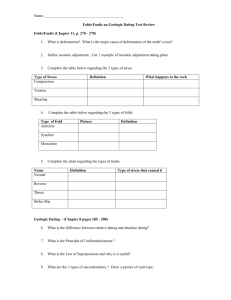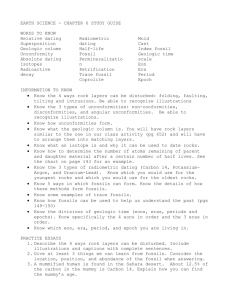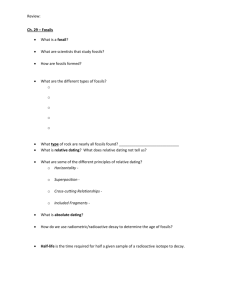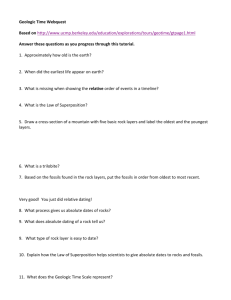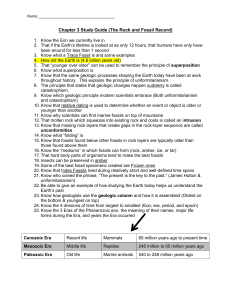Unit 3 - Earth History - Troup County School System
advertisement
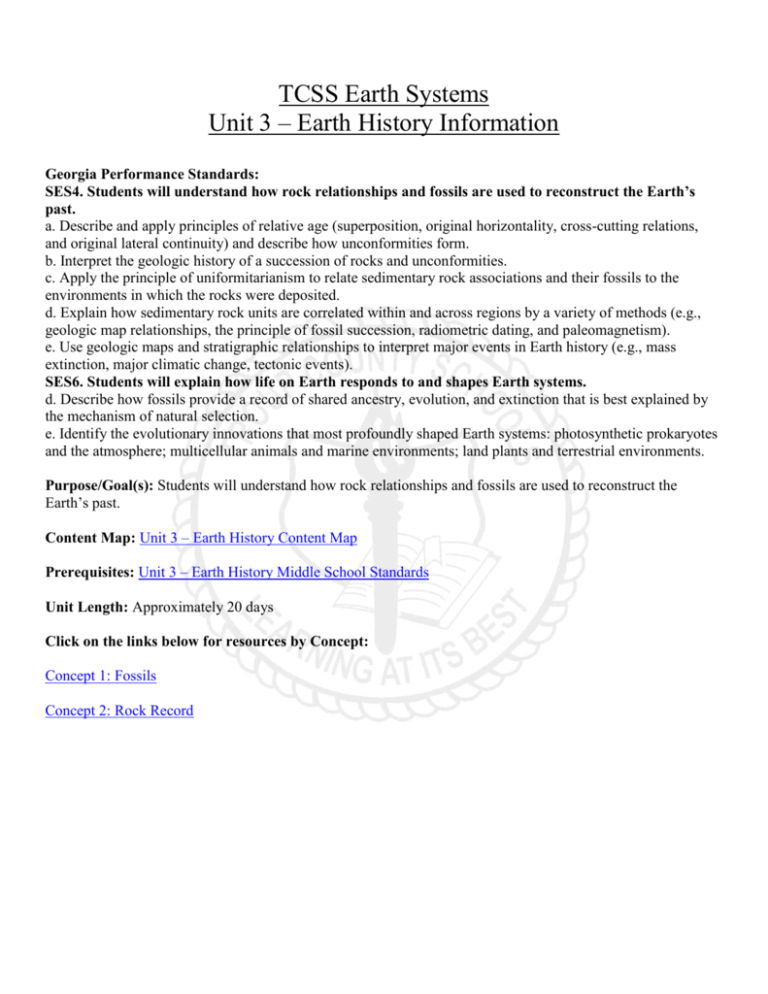
TCSS Earth Systems Unit 3 – Earth History Information Georgia Performance Standards: SES4. Students will understand how rock relationships and fossils are used to reconstruct the Earth’s past. a. Describe and apply principles of relative age (superposition, original horizontality, cross-cutting relations, and original lateral continuity) and describe how unconformities form. b. Interpret the geologic history of a succession of rocks and unconformities. c. Apply the principle of uniformitarianism to relate sedimentary rock associations and their fossils to the environments in which the rocks were deposited. d. Explain how sedimentary rock units are correlated within and across regions by a variety of methods (e.g., geologic map relationships, the principle of fossil succession, radiometric dating, and paleomagnetism). e. Use geologic maps and stratigraphic relationships to interpret major events in Earth history (e.g., mass extinction, major climatic change, tectonic events). SES6. Students will explain how life on Earth responds to and shapes Earth systems. d. Describe how fossils provide a record of shared ancestry, evolution, and extinction that is best explained by the mechanism of natural selection. e. Identify the evolutionary innovations that most profoundly shaped Earth systems: photosynthetic prokaryotes and the atmosphere; multicellular animals and marine environments; land plants and terrestrial environments. Purpose/Goal(s): Students will understand how rock relationships and fossils are used to reconstruct the Earth’s past. Content Map: Unit 3 – Earth History Content Map Prerequisites: Unit 3 – Earth History Middle School Standards Unit Length: Approximately 20 days Click on the links below for resources by Concept: Concept 1: Fossils Concept 2: Rock Record TCSS Earth Systems Earth History Unit Information Concept, Essential Question(s), and Standard(s) Concept 1: Fossils EQ1: What are some of the methods that scientists use to learn about the Earth’s long history? SES4. Students will understand how rock relationships and fossils are used to reconstruct the Earth’s past. a. Describe and apply principles of relative age (superposition, original horizontality, cross-cutting relations, and original lateral continuity) and describe how unconformities form. c. Apply the principle of uniformitarianism to relate sedimentary rock associations and their fossils to the environments in which the rocks were deposited. d. Explain how sedimentary rock units are correlated within and across regions by a variety of methods (e.g., geologic map relationships, the principle of fossil succession, radiometric dating, and Vocabulary Essential* Ancestry Cross-Cutting Relations Evolution Extinction Fossils Fossil Succession Geologic Map Natural Selection Original Horizontality Original Lateral Continuity Paleomagnetism Radiometric Dating Sedimentary Superposition Uniformitarianism Supplemental** Eon Epoch Era Geologic time scale Mass Extinction Period Precambrian Cross-Cutting Relationship Principle of Inclusions Original Horizontality Relative-Age Dating Superposition Uniformitarianism Absolute-Age Dating Half-life Resources [Back to Top] PowerPoints and Notes: Fossils and Natural Selection Determining the Age of Rocks Geologic Time and Earth’s Biological History Relative Dating Uniformitarianism The Fossil Record and Geologic Time Scale Reading the Rock Record Animations and Videos: Animation Fossil Formation (time 3:33) What is Relative Dating? (time 8:06) Handouts and Activities: Time Line Activator: For this activity you will make a timeline of your life. This will allow students to grasp the idea of time in sequential order. Cross Cutting Relationship Handouts: This handout allows students to practice the concept of cross cutting relationships. Should be used after teaching the concept. Relative Dating Worksheet: This handout allows you to practice the concepts of Uniformitarianism, Superposition, Original Horizontality, and Cross-cutting relationships. Great way to have them practice the concepts Relative Age Dating Principles: Students are asked to use the principles of cross-cutting relationships and superposition determine the age of craters. Unit One Worksheet Geology: Packet could be used throughout course. For the purposes of this unit you would want to use pages 5-9 to assess their knowledge of concepts taught in this unit. Superposition Mystery Lab: To be able to determine the order of a sequence of events and apply this skill to a geological Assessment Concept 1: Sample Assessment Items TCSS Earth Systems Earth History Unit Information paleomagnetism). SES6. Students will explain how life on Earth responds to and shapes Earth systems. d. Describe how fossils provide a record of shared ancestry, evolution, and extinction that is best explained by the mechanism of natural selection. Radioactive Decay Radiocarbon Dating Radiometric Dating Altered Hard Part Cast Index Fossil Mineral Replacement Mold Original Preservation Trace Fossil *Essential vocabulary listed in the GPS Standards **Supplemental vocabulary listed in the state frameworks and/or other state document exercise, in order to determine a sequence of hypothetical geological events and their relative age. Earth Science Relative Dating Virtual Lab: Students with the use of technology will practice the ideal of relative dating. Good summarizing activity. Using Relative Dating and Unconformities to Determine Sequences of Events: In this lab we will deal with relative dating. In relative dating, events are established as 1) older than, 2) younger than, or 3) the same age as other geologic events. Lab Activity – Relative Dating: When observing a road-cut the different stratum of rocks becomes obvious. Geologic events such as deposition, erosion, volcanism and faulting are preserved in the rock and it is possible to determine the sequence of events from oldest to most recent. Sequencing events establishes a relative age of a stratum. The process of showing that rocks or geologic events occurring at different locations are the same age is called correlation. Index fossils and similar rocks types help geologists establish correlations between distance rock outcrops. TCSS Earth Systems Earth History Unit Information Concept, Essential Question(s), and Standard(s) Concept 2: Rock Record EQ1: How did complex life develop and diversity during the three eras of the Phanerozoic as the continents moved into their present positions? SES4. Students will understand how rock relationships and fossils are used to reconstruct the Earth’s past. b. Interpret the geologic history of a succession of rocks and unconformities. e. Use geologic maps and stratigraphic relationships to interpret major events in Earth history (e.g., mass extinction, major climatic change, tectonic events). SES6. Students will explain how life on Earth responds to and shapes Earth systems. e. Identify the evolutionary innovations that most profoundly shaped Earth systems: photosynthetic prokaryotes and the atmosphere; multicellular animals and marine environments; land plants and terrestrial environments. Vocabulary Essential* Geologic History Land Plants Major Climatic Change Marine Environments Mass Extinction Multicellular Animals Photosynthetic Prokaryotes Stratigraphic Relationships Succession Tectonic Events Terrestrial Environments Unconformities Resources [Back to Top] PowerPoints and Notes: Cenozoic Era Paleozoic Era Mesozoic Era Earth Systems Chapter 23 Notes(Teacher and Student) o Recommend using these Animations and Videos: Mesozoic Era (time 5:00) The Day the Mesozoic Died (time 33:43) Handouts and Activities: Earth’s History Timeline Lab: We are going to make a scale model of Earth’s history. A scale model means that the timeline accurately depicts different lengths of time. All of the Supplemental** times that we are going to deal with in this lab are in millions Cambrian Explosion Paleogeography of years ago (mya). To figure out the lengths that we need in Passive Margin this lab use the following proportion Regression Precambrian and Paleozoic Transparency Activity: Students Transgression will use the attached transparency or sheet to answer questions Amniotic Egg about the Precambrian and Paleozoic time periods. Iridium Paleozoic Era: Life Explodes (Worksheet 1) (Worksheet 2): Phytoplankton Review sheet about what occurred during the Paleozoic Era. Bipedal Good summative assessment. Work best with student fill in Homo Sapiens blank notes. *Essential vocabulary listed Mesozoic Era: Age of Reptiles: Review sheet about what in the GPS Standards occurred during the Mesozoic Era. Good summative assessment. Work best with student fill in blank notes. **Supplemental vocabulary Cenozoic Era: The Age of Mammals: Review sheet about listed in the state what occurred during the Cenozoic Era. Good summative frameworks and/or other assessment. Work best with student fill in blank notes. state document Assessment Concept 2: Sample Assessment Items

